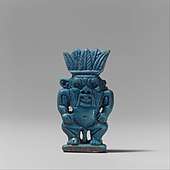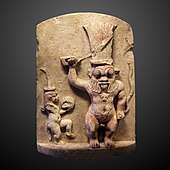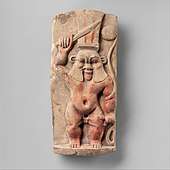Bes
Bes (/ˈbɛs/; also spelled as Bisu), together with his feminine counterpart Beset, is an Ancient Egyptian deity worshipped as a protector of households and, in particular, of mothers, children and childbirth. Bes later came to be regarded as the defender of everything good and the enemy of all that is bad. Bes may have been a Middle Kingdom import from Nubia or Somalia,[1] and his cult did not become widespread until the beginning of the New Kingdom. Worship of Bes spread as far north as the area of Syria, and later into the Roman and Achaemenid Empires.
| Bes | |
|---|---|
Bes capital from Dendera (Egypt) | |
| Major cult center | New Kingdom |
| Symbol | Ostrich feather |
| Consort | Beset |
Worship
.jpg)
| Part of the myth series on |
| Religions of the ancient Near East |
|---|
| Pre-Islamic Arabian deities |
| Arabian deities of foreign origin |
|
Bes was a household protector, becoming responsible – throughout ancient Egyptian history – for such varied tasks as killing snakes, fighting off evil spirits, watching after children, and aiding women in labour by fighting off evil spirits, and thus present with Taweret at births.
Images of the deity, quite different from those of the other gods, were kept in homes. Normally Egyptian gods were shown in profile, but instead Bes appeared in full face portrait, ithyphallic, and sometimes in a soldier's tunic, so as to appear ready to launch an attack on any approaching evil. He scared away demons from houses, so his statue was put up as a protector. Since he drove off evil, Bes also came to symbolize the good things in life – music, dance, and sexual pleasure. In the New Kingdom, tattoos of Bes could be found on the thighs of dancers, musicians and servant girls. Many instances of Bes masks and costumes from the New Kingdom and later have been uncovered. These show considerable wear, thought to be too great for occasional use at festivals, and are therefore thought to have been used by professional performers, or given out for rent.
Later, in the Ptolemaic period of Egyptian history, chambers were constructed, painted with images of Bes and his wife Beset, thought by Egyptologists to have been for the purpose of curing fertility problems or general healing rituals.
Like many Egyptian gods, the worship of Bes or Beset was exported overseas. While the female variant had been more popular in Minoan Crete, the male version would prove popular with the Phoenicians and the ancient Cypriots.[2] The Balearic island of Ibiza derives its name from the god's name, brought along with the first Phoenician settlers in 654 BC. These settlers, amazed at the lack of any sort of venomous creatures on the island, thought it to be the island of Bes (<איבשם> ʔybšm, *ʔibošim, yibbōšīm "dedicated to Bes"). Later the Roman name Ebusus was derived from this designation.
At the end of the 6th century BC, images of Bes began to spread across the Achaemenid Empire, which Egypt belonged to at the time. Images of Bes have been found at the Persian capital of Susa, and as far away as central Asia. Over time, the image of Bes became more Persian in style, as he was depicted wearing Persian clothes and headdress.
Iconography
Modern scholars such as James Romano claim that in its earliest inception Bes was a representation of a lion rearing up on its hind legs.[3] After the Third Intermediate Period, Bes is often seen as just the head or the face, often worn as amulets.
 Amulet of Bes; 1070-712 BC; faience; height: 3.7 cm; Metropolitan Museum of Art (New York City)
Amulet of Bes; 1070-712 BC; faience; height: 3.7 cm; Metropolitan Museum of Art (New York City) Bes and Beset; 664-332 BC; limestone; height: 31.7 cm, width: 22.5 cm; Louvre
Bes and Beset; 664-332 BC; limestone; height: 31.7 cm, width: 22.5 cm; Louvre Cypriot statuette of Bes; late 6th–early 5th century BC; limestone; overall: 14 x 8.3 x 7 cm; Metropolitan Museum of Art
Cypriot statuette of Bes; late 6th–early 5th century BC; limestone; overall: 14 x 8.3 x 7 cm; Metropolitan Museum of Art Statuette of Bes; 525 BC; bronze; overall: 8 x 3.5 x 2.2 cm; Cleveland Museum of Art (Cleveland, Ohio, USA)
Statuette of Bes; 525 BC; bronze; overall: 8 x 3.5 x 2.2 cm; Cleveland Museum of Art (Cleveland, Ohio, USA) Cosmetic container; 525–404 BC; faience; height: 9.2 cm, width: 4.4 cm; Metropolitan Museum of Art
Cosmetic container; 525–404 BC; faience; height: 9.2 cm, width: 4.4 cm; Metropolitan Museum of Art Stela of Bes; 4th century BC-1st century AD; painted limestone; height: 38.7 cm, width: 17.7 cm; Metropolitan Museum of Art
Stela of Bes; 4th century BC-1st century AD; painted limestone; height: 38.7 cm, width: 17.7 cm; Metropolitan Museum of Art.jpg) Bell in the form of Bes; 332-30 BC; cupreous metal; height: 6.3 cm, diameter: 4.6 cm; Metropolitan Museum of Art
Bell in the form of Bes; 332-30 BC; cupreous metal; height: 6.3 cm, diameter: 4.6 cm; Metropolitan Museum of Art.jpg) Fresco from the Temple of Isis in Pompeii depicting Bes, in the Naples National Archaeological Museum (Italy)
Fresco from the Temple of Isis in Pompeii depicting Bes, in the Naples National Archaeological Museum (Italy)
Popular culture
- Bes appears, as part of the delegation of Egyptian gods, in The Sandman: Season of Mists (December 1990 – July 1991), by Neil Gaiman.
- Bes is a friend and helper to the heroes in Pyramid Scheme (2001) by Eric Flint and Dave Freer.
- Bes is an important character in the books of the saga The Kane Chronicles (2010–2012) by Rick Riordan.
- Bes appears in the video game Realm of the Mad God (2011) as a boss of an Egyptian themed dungeon known as the "Tomb of the Ancients", alongside Nut and Geb.
Bibliography
| Wikimedia Commons has media related to Bes. |
- The Complete Gods and Goddesses of Ancient Egypt, Richard H. Wilkinson. ISBN 0-500-05120-8
- The Oxford History of Ancient Egypt, Ian Shaw. ISBN 0192804588
References
- Mackenzie, Donald A. (1907). Egyptian myth and legend. With historical narrative, notes on race problems, comparative, etc. London: The Gresham Publishing. p. 312.
The grotesque god Bes also came into prominence during the Eighteenth Dynasty; it is possible that he was introduced as early as the Twelfth. Although his worship spread into Syria he appears to have been of African origin and may have been imported from Somaliland.
- Weingarten, Judith, "The Arrival of Bes[et] on Middle-Minoan Crete". In: Jana Mynárová, Pavel Onderka, and Peter Pavúk (ed.s): There and Back Again – the Crossroads II. Proceedings of an International Conference Held in Prague, September 15-18, 2014. Czech Institute of Egyptology, Faculty of Arts of the Charles University, Prague 2015, ISBN 978-80-7308-575-9, pp. 181–196.
- Richard H. Wilkinson: The Complete Gods and Goddesses of Ancient Egypt. Thames & Hudson, London 2017, ISBN 0-500-05120-8, p. 104.
Further reading
- Dasen, Veronique (2013). Dwarfs in Ancient Egypt and Greece. Oxford: Oxford University Press. ISBN 0-199-68086-8